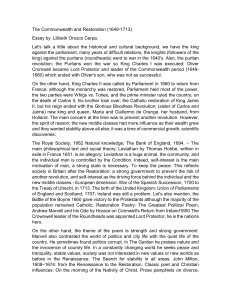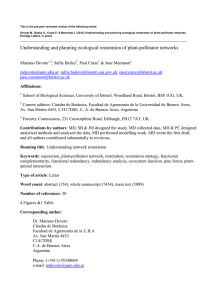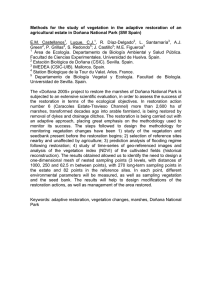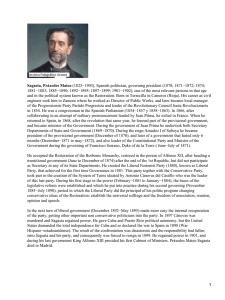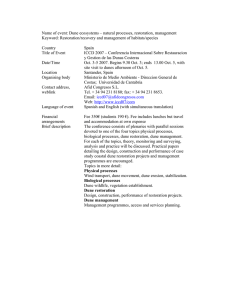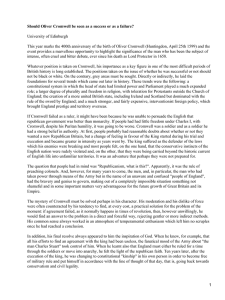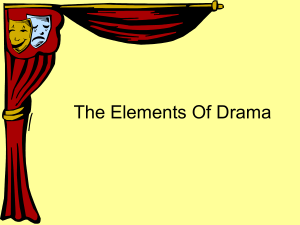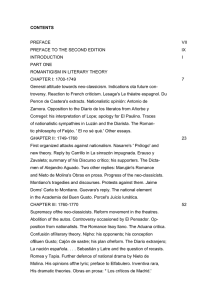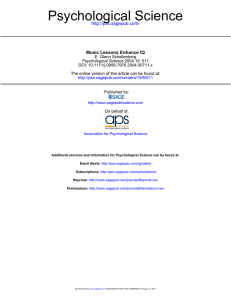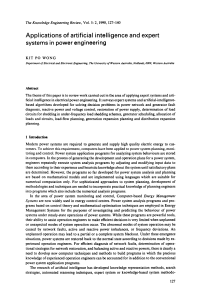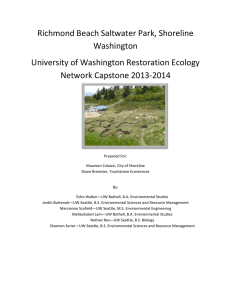The Commonwealth and Restoration 1649−1713 Historical and cultural milieu
Anuncio
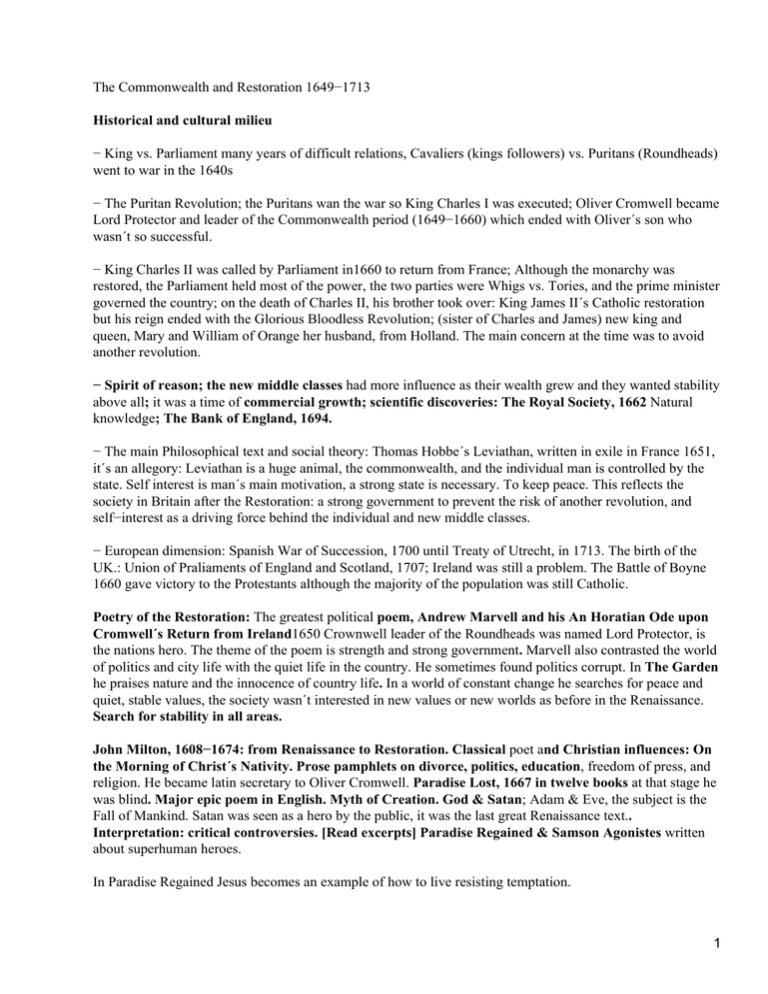
The Commonwealth and Restoration 1649−1713 Historical and cultural milieu − King vs. Parliament many years of difficult relations, Cavaliers (kings followers) vs. Puritans (Roundheads) went to war in the 1640s − The Puritan Revolution; the Puritans wan the war so King Charles I was executed; Oliver Cromwell became Lord Protector and leader of the Commonwealth period (1649−1660) which ended with Oliver´s son who wasn´t so successful. − King Charles II was called by Parliament in1660 to return from France; Although the monarchy was restored, the Parliament held most of the power, the two parties were Whigs vs. Tories, and the prime minister governed the country; on the death of Charles II, his brother took over: King James II´s Catholic restoration but his reign ended with the Glorious Bloodless Revolution; (sister of Charles and James) new king and queen, Mary and William of Orange her husband, from Holland. The main concern at the time was to avoid another revolution. − Spirit of reason; the new middle classes had more influence as their wealth grew and they wanted stability above all; it was a time of commercial growth; scientific discoveries: The Royal Society, 1662 Natural knowledge; The Bank of England, 1694. − The main Philosophical text and social theory: Thomas Hobbe´s Leviathan, written in exile in France 1651, it´s an allegory: Leviathan is a huge animal, the commonwealth, and the individual man is controlled by the state. Self interest is man´s main motivation, a strong state is necessary. To keep peace. This reflects the society in Britain after the Restoration: a strong government to prevent the risk of another revolution, and self−interest as a driving force behind the individual and new middle classes. − European dimension: Spanish War of Succession, 1700 until Treaty of Utrecht, in 1713. The birth of the UK.: Union of Praliaments of England and Scotland, 1707; Ireland was still a problem. The Battle of Boyne 1660 gave victory to the Protestants although the majority of the population was still Catholic. Poetry of the Restoration: The greatest political poem, Andrew Marvell and his An Horatian Ode upon Cromwell´s Return from Ireland1650 Crownwell leader of the Roundheads was named Lord Protector, is the nations hero. The theme of the poem is strength and strong government. Marvell also contrasted the world of politics and city life with the quiet life in the country. He sometimes found politics corrupt. In The Garden he praises nature and the innocence of country life. In a world of constant change he searches for peace and quiet, stable values, the society wasn´t interested in new values or new worlds as before in the Renaissance. Search for stability in all areas. John Milton, 1608−1674: from Renaissance to Restoration. Classical poet and Christian influences: On the Morning of Christ´s Nativity. Prose pamphlets on divorce, politics, education, freedom of press, and religion. He became latin secretary to Oliver Cromwell. Paradise Lost, 1667 in twelve books at that stage he was blind. Major epic poem in English. Myth of Creation. God & Satan; Adam & Eve, the subject is the Fall of Mankind. Satan was seen as a hero by the public, it was the last great Renaissance text.. Interpretation: critical controversies. [Read excerpts] Paradise Regained & Samson Agonistes written about superhuman heroes. In Paradise Regained Jesus becomes an example of how to live resisting temptation. 1 Prose of the second half of the seventeenth century: John Bunyan: The Pilgrim´s Progress it´s an allegory, 1678−1684, best−known prose text of the period. Back to medieval allegory. Dream−vision. Plot. Questions the false values of the world. Establishes social values of English society for more than two centuries: Christianity, faith and stability. Possibly the most widely read book in English literature. The Authorized Version of the Bible. The Book of Common Prayer (1662) Augustans and Satires Augustans: admiration of the classical age of Augustus (+A.D.14). The rational basis of thought vs. Emotion (emotion takes second place). Social satire. The poetry of John Wilmot, Earl of Rochester: wit and satire on humankind his life became a kind of symbol of the Restoration: a rake, a man who gave his life to pleasure sex and alcohol. His poetry is often witty and rude. In some ways Milton is the last metaphysical lyric poet, with complex poems about love and life, but in others he is the first of the new Augustan age. Samuel Butler´s Hudibras (finished in 1678); its popularity; the influence of Cervante´s Don Quixote; mock romance, long satirical poem. It´s satirical comments are aimed at every religious, academic and political subject of the age. John Dryden: Poet Laureate, playwright, translator and essayist. Heroic Stanzas praised Cromwell on his death in 1658, To His Sacred Majesty welcoming the return of the king in 1660. Absalom and Architophel (1681): satire of particular people and situations. Essay of Dramatic Poesy (1668) and the beginnings of literary criticism. He made his career as a professional author Restoration Drama Restoration drama vs. Elizabethan drama. Only two public theatres and upper/upper−middle class audience. Plays reflect manners and morals of the court returned from France. Restoration comedy = Comedy of Manners. The main subject of these plays was love (older men of women looking for younger lovers, upper class manners contrasting with middle−class values, country life vs. City life, sex was a major subject, with comic treatment to sexual themes. Comedy. J. Dryden´s tragi−comedy: Marriage−á−la−Mode and All for love (tragedy which return to the characters of Antony & Cleopatra). George Country Etherege´s She Wou´d if She Cou´d and The Man of Mode are the most successful of the genre. William Wycherley´s The Country Wife [read excerpt]. The question of immorality: Jeremy Collier´s reaction against the theatre and the issue of censorship. William Congreve´s comedy of manners: The Way of the World (1700) [read excerpt]. Male and female roles. London society. Aphra Behn´s 18 plays (The Rover). Her main themes where about arranged and unsuitable marriages. Tragedy and serious drama: Dryden´s & Shadwell´s re−writing of Shakespeare's plays, adapted to the taste of the middle classes. The social changes of the seventeenth−century here the society is made safe by the sacrifice of the hero, nothing to do with Jacobean drama. Main tragic form of the Restoration: heroic 2 tragedy. Politics and drama at the beginning of the new century in 1737 the Stage Licensing Act was introduced to prevent playwrights making fun of politicians . John Gay's The Beggar's Opera (1728) music, 1 of the most popular works to satirize the politicians and the false values of society. Henry Fielding´s political comedy decided the Prime Minister Robert Walpole to censor all plays (censorship which has remained in force until 1968). 3
